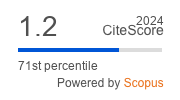Psycholinguistic Representation of Individual Traumatic Memory in the Context of Social and Political Ambiguity
Keywords:
traumatic memory, post-traumatic stress disorder, psycholinguistic representation of traumatic memory, psychographological analysis, propositional analysis, frame analysis.Abstract
The paper focuses on a psycholinguistic study of individual traumatic memory. Among psycholinguistic tools of the research are psychographological analysis, propositional analysis, and frame analysis. The results of psychographological analysis revealed differences between psycholinguistic representations of traumatic events as compared to psycholinguistic representation of neutral events in norm for written speech. Higher psychographological indices in representation of traumatic events show the emotional lability (high sentence length), low awareness and meaningfulness of the event (high quotient of logical coherence), and low motivation (small number of words in the narratives). Frame analysis allowed revealing distribution of traumatic events in the context of political and social ambiguity. Propositional analysis showed distribution of propositional elements in the narration of traumatic events, which express the meaning of traumatic events in a person’s life (attitude); significance of external circumstances in the awareness of the traumatic event (external object); the main participants of the traumatic event (external argument); the narrator and his/her role in the traumatic event (internal argument); low importance of localization and chronological order of the traumatic event (context); the secondary (passive) role of narrator in the traumatic event and emphasizing the importance of the external circumstances (internal objects). The results of T-test show the differences in psycholinguistic representation of traumatic memory between two samples: respondents without PTSD (95 people) and respondents with PTSD and tendencies to PTDS (111 people). The narrators of the second sample (with PTSD) have higher indices of norm deviations in psychographological analysis, a higher percent of the attitude and internal argument in the predicate in propositional analysis, lower variety of frame clusters of traumatic events than narrators of the first sample (without PTSD).
References
- Alvarez-Conrad J., Zoellner L. A., Foa E.B. (2001). Linguistic predictors of trauma pathology
and physical health. Applied Cognitive Psychology, 15(7), 159–170. - Anderson, J. R., Bower, G. (1974). Propositional theory of recognition memory. Memory &
Cognition, 2(3), 406–412. - Barclay, C.R. (1996). Autobiographical Remembering: Narrative Constraints on Objectified
Selves. Remembering our Past, 94–128. - Bremner, J.D. (2001). Hypothesis and controversies related to effects of stress on the
hippocampus: An argument for stress-induced damage to the hippocampus in patients with
posttraumatic stress disorder. Hippocampus, 11, 75–81. - Colman, A. (2003). Oxford Dictionary of Psychology. Oxford: Oxford University Press.
- Garcia D., Sikström S. (2013).Quantifying the semantic representation of adolescents’
memories of positive and negative life events. Journal Happiness Study, 14,1309–1323. - Foa E., Molnar, C., Cashman L. (1995). Change in rape narratives during exposure therapy for
posttraumatic stress disorder. Journal of Traumatic Stress, 8, 675–690. - Fornberg, E. (1997). Amygdala, Emotions, Motivation and Depressive States. (pp. 301–333).
In, R. Plutchnik and H. Kellerman (Eds.), Emotion: Theory, Research, and Experience, 3. - Herman, J. (1997). Trauma and Recovery: The Aftermath of Violence – from Domestic Abuse
to Political Terror. Cambridge, Mass.: MIT Press. - Klein, K. (2002). Stress, Expressive Writing and Working Memory. The Writing Cure: How
Expressive Writing Promotes Health and Emotional Well-being. Washington, D.C.: American
Psychological Association. - Marshall, R. D., Turner, J. B, R. Lewis-Fernandez, R. (2006). Symptom patterns associated
with chronic PTSD in male veterans: new findings from the National Vietnam Veterans Readjustment
Study. Journal of Nervous and Mental Disease, 194 (4), 275–278. - Meichenbaum, D. A. (2004). Clinical Handbook for Assessing and Treating Adults with PostTraumatic Stress Disorder (PTSD). Waterloo: Institute Press.
- Pennebaker, J.W., Francis, M.E. (1996). Cognitive, emotional and language processes in
disclosure. Cognition and Emotion, 10, 601–626. - Shapiro F. (2001) Eye Movement Desensitization and Reprocessing. NY : Guilford.
- Taylor, S. (2006). Clinican’s Guide to PTSD: A Cognitive-Behavioral Approach. Guilford:
Guilford Press. - Tulving, E. (1972). Episodic and Semantic Memory. New York: Academic Press.
- Watzlawick, P., Weakland, J. H., Fisch, R. (1974). Change: Principles of Problem Formation
and Problem Resolution. Oxford: Oxford University Press. - Yehuda, R.B., Kahana, K., Binder-Byrnes S.M., Woutwick, J.M.,Giller, E.L. (1995). Low
urinary cortisol excretion in Holocaust survivors with posttraumatic stress disorder. American Journal of
Psychiatry 152, 982-986. - Zasiekina, L. (2012). Psykholingvistychna reorhanizatsia travmatychnoyi pamiati z
perspektyvy psykhichnoho zdorovia [Psycholinguistic reorganization of traumatic memory from the
perspective of individual psychic health]. Visnyk of National Academy of Border Service of Ukraine,
Retrieved from http://archive.nbuv.gov.ua/ejournals/Vnadps/2012_1/12zlvpzo.pdf - Zasiekina, L., Zasiekin, S. (2008). Psykholinhvistychna Diahnostyka [Psycholinguistic
Diagnostic]. Lutsk: Vezha.







 Creative Commons «Attribution» 4.0
Creative Commons «Attribution» 4.0